The Editing Journey, Or There and Back Again: A Book’s Tale
Bringing a book to life is a journey. You know your story’s origin point: butt in chair, hands over keyboard, you type type type until you’re done. But what happens after THE END? Buckle in, my friend. We’re going on the Editing Journey.
Like every good hero’s path, the Editing Journey is full of twists and turns, false starts and sudden stops, and hidden dangers along the way. But! Despite the obstacles, this road has certain signposts to guide a magic writer like you toward your ultimate destination: publication. And, despite the “two-steps-forward-one-step-back” feeling of writing and editing a book, there is a process that, if you follow it, will help you reach that goal faster and at the end come out with a better product.
And, you do want the best book you can produce, right?
So, here’s the Editing Journey, broken down into its basic phases.
Phase One: Early Drafting
Because you are a magic writer, I’m sure you’re quite familiar with this phase: the write, rewrite, write some more, rewrite that, then start over and rewrite the whole darn thing a million times because you have six new ides for chapter twelve at two o’clock in the morning [sharp inhale here] . . . yep, I’ve been here.
This is important stuff. And, did you know that during all this writing and rewriting, you’re editing too? First drafts are junk. They’re the head-clearing and idea-testing fool’s gold before you get to the real good stuff.
But, you ask, drafting isn’t editing, right? It’s writing!
Oh, but I believe it is! Here’s why:
- You edit internally as you write. No matter how free-flowing and loosey-goosey your writing process is during drafting, every word passes through your internal filter. “Should I use said here or said sadly?” <– Making the choice between those options is editing.
- You rewrite your draft and make changes. You do rewrite your first draft, correct? Assuming you do, you may change words, your story’s structure or a scene’s opening, or catch obvious mistakes and typos. That’s editing!
- You probably do a self-edit on your “final” draft. Once the story is all done, you go back and read through it to do your own self-editing. Or, if you don’t, you should. I highly, highly recommend this. You’d be amazed at what you catch here—most definitely not everything, but a good chunk.
Okay. So. You, as the magic writer you are, get this whole Editing Journey kicked off and rolling simply by writing and self-editing. But, once you’ve got a “final” draft on your hands, what’s next?
Phase Two: Final Draft Editing
This phase along the journey is when things really get interesting, and the stakes get higher for your book baby. Here’s where you *GULP* put your story out in the wild and see if it survives. Yup, it’s the dreaded Feedback Forest.
But this phase is critical. It makes or breaks the publish-ability of your book. If you write what you think is the next New York Times bestseller, but never get confirmation of that perfectly understandable bias from, you know, readers who might buy the book and put it on the bestseller list, then you’re setting yourself up for extra-crushing disappointment.
We don’t want that.
So, pay extra attention to these editing signposts.
- The beta read. You want people to buy your book in order to read it, right? Sure you do. So, if you’re looking to perhaps make a red cent on your story, you gotta know what your audience thinks before you shell out the big bucks to self-publish or go through the querying heart-shredding. And the best way to do that is to find a big handful of people to put their eyes on your book and let you know what they think. Give it to your mom. Your best friend. Your hair dresser. Your neighbor. Stop random people on the street and shove your printed manuscript into their very surprised hands. (Well, maybe not that.) Find 5, 10, 20 people, however many opinions you think you need, and ask them to read it and give their honest feedback. And honest feedback they shall give you, so gird thy heart well. Those critiques, even kind ones, might not be words you want to hear, especially if your beta readers are any good and not, say, your mom.
And what do you do with all that feedback? You put it aside for a while, and then you think about it long and hard to decide if the feedback you got is worth incorporating into your story.If it is, and only you can be the judge of that, go directly to Phase 1, Steps 2 and 3. Do not pass “Go.” Do not collect $200.
- The manuscript evaluation/developmental edit. If you don’t want the hassle of shoving your book at every random stranger to beta read, perhaps don’t trust that beta readers could give you informed advice about the craft of writing, or have some awesome feedback about what isn’t working in your story but no idea how to fix it, I suggest you level up by hiring a professional editor to do a manuscript evaluation and/or developmental edit. In fact, I believe you should do this even if you had a gold-star experience with your beta readers and they all told you your book was perfect and nothing needed to change. (Er, especially if they all told you that.)
A manuscript evaluation or developmental edit (I’ll explain the difference in a bit) will get your work into the hands of a professional who can read your story, notice instantly what doesn’t work, and then give you the tools you need to fix it. They have training in craft, experience reading lots of books (perhaps even some that had the same issues as yours), and maybe even a background in writing or teaching. They’ll find the goblins hiding in the weeds of your story that you didn’t know existed and your beta readers didn’t even notice.Which is best, an evaluation or a developmental edit? My answer: it depends on what stage of writing you’re in. A developmental editor will want the full, complete story, and sometimes even the draft that’s been through rewrites. That’s so they can focus on the entire story arc, beginning, middle, and end, as well as the full character development, plot, and other story mechanics.An evaluation can happen at any point in your writing process, whether your story is finished or not. As an example: I’ve been working on a book for the last three years (I’m a very slow writer.) I wanted a professional’s eyes after I’d gotten halfway through the first draft of the story, just so I could get confirmation that I was on the right track before continuing. I wanted to make sure I had the right set up, beginning story arc, and good characters by a certain point in the plot. If not, I didn’t want to waste time drafting the rest; I wanted to go back and fix those issues instead. I also wanted a little encouragement that the story idea and themes I had were solid. So, I hired an excellent manuscript evaluator who did just that. I’m now moving forward with confidence.
Wherever you end up at this point in the journey, go back again to Phase 1, Steps 2 and 3, and get all that juicy feedback written into your book! Because once you move on to the next phase, all that fixing is over. It will be too late to develop your villain or add a plot twist. So, spend as much time as your story needs here to save you mucho headache later.
Phase Three: Manuscript Polish
Yay! Your story is done, with a capital D. It’s been beta read, critiqued, rewritten, developmentally edited, rewritten again. Sheesh. You’re tired. You’re over it already.
Don’t give up yet, magic writer! You’re only halfway there—but it gets easier on you at this point.
Here are the next waystations along the road.
- The line edit. Depending on your writing chops, you may not need to stop at this junction. A line edit is a pass through your manuscript to fix clunky sentences, or those that don’t flow well, or to rewrite whole head-scratching paragraphs. It’s also the place to correct issues with voice—that is, when a character has a certain way of saying things in one chapter and then changes their speech patterns or vocal characterizations completely in the next. This is a true deep dive into the language of your story to make sure it’s consistent, clear, and concise. If you’re a clean, proficient writer, a line edit won’t be all that needed. (But it couldn’t hurt.)
- The copyedit. The copyedit is what most amateur and beginning writers think of as a proofread. It’s not. Full stop.
One more time for those of you in the back.A COPYEDIT IS NOT A PROOFREAD.What it is is a deep look at your GUMs: your grammar, usage, and mechanics. It’s the spelling, capitalization, punctuation, word choice, continuity, fact-checking, verb agreement, tense, and other nuts and bolts of your writing.
If you’re on a limited budget and trying to decide between the two, go with a copyedit at least. Readers, depending on their sophistication, might forgive or overlook writing that doesn’t flow the best, but misspell a word? Out come the torches and pitchforks.
Or you could hire an editor that offers both in one fell swoop: check out my Style Tune Up package for just that option.
Phase Four: Design/Formatting/Typesetting
Still here, magic writer? Awesome! You have almost reached your goal. In fact, I bet if you squint, you can see it there, off in the distance, a shining city on a hill. Publicationlandia!!
But, there’s still one more point we have to reach in our Editing Journey.
- Cover design. Okay, this is technically not part of editing. But it is a nice side trip along the way. You’ll need a cover for your book, either professionally designed or DIY.
- Formatting/typesetting. Depending on whether you’re traditionally or self-publishing, the finished and polished manuscript that you’ve signed off on is now submitted to either a book formatter or a typesetter. They both do functionally the same thing, just within different realms. A traditional publisher lumps the formatting of the book in with typesetting, since it’s all done in-house. When you self-publish you usually hire someone to do the formatting (you can DIY here) and then you “typeset” by submitting it to KDP or another self-publishing service.
- Proofreading. And here is where editing swoops back in for one last hurrah! This does apply more to traditional publishing, but it’s important in self-publishing too. I’ll explain.
In traditional publishing, the typesetter prepares “proofs” of the pages of your book. Which is nowadays just a fancy term for a PDF of your nicely designed, formatted, and laid-out book. The publisher then sends the proof to a . . . you guessed it . . . PROOFREADER who compares the copyedited manuscript to the proof to make sure no mistakes or changes were made during formatting or typesetting.If you self-publish, a proofreader can perform basically the same job, but it might be you who is acting as the typesetter and/or formatter. In this case, a proofread is just one final check of your finished book before you upload it to your publishing platform.
Phase Five: Publication
And that’s it! If you’ve gone through all the steps in the Editing Journey, you’re now ready to be, soon to be, or are a published author. Congrats!
And if you’re looking for a trusty sidekick to walk with you on this journey, I can help you with a manuscript evaluation, line edit, copy edit, or proofread. Let’s share the road!




